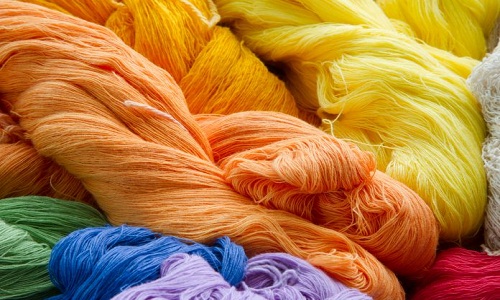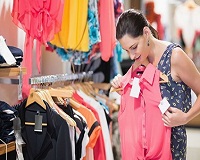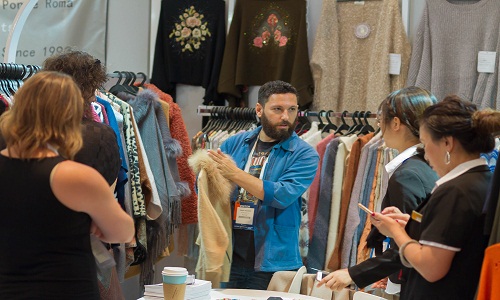FW
Apparel Textile Sourcing Canada (ATSC) is on August 20 to 22, 2018. ATSC has doubled in size from 2017 to include additional categories such as accessories, giftware, home electronics, footwear, luggage and houseware and general merchandise.
Almost 600 booths are at the show floor, featuring latest and greatest trends and unique offerings in apparel and textile from more than 20 countries, including Canada, China, Bangladesh, India, Pakistan, the US, the UK, Turkey, Switzerland, Spain, Nepal and Ukraine.
The event provides thousands of attendees with unprecedented networking and business opportunities with international suppliers on Canadian turf. It is also a major feat for local businesses that are poised to benefit from making unprecedented connections and securing deals with top-rate international suppliers.
During the exhibition, more than 20 lectures and forums will be held, and world-renowned industry experts will explain business knowledge, fashion trends and trade trends to the audience. More than 5000 visitors are expected to attend over the three-day event – now in its third year – including apparel and fashion executives, influencers, designers, retailers, importers, wholesalers, merchandisers, buyers and suppliers. A unique on-site business matchmaking service will be offered to bring overseas suppliers and contacts together with interested Canadian show attendees.
"A by-product of spinning, hydrogen sulphide (H2S) is a toxic gas that causes eye irritation, function impairment, and neurobehavioural changes. The toxic gas smells of rotten eggs. Other harmful chemical for health and environment are: Sodium hydroxide (NaOH) and sulphuric acid (H2SO4). NaOH is highly toxic if absorbed through inhalation, ingestion, or skin contact, and is known to cause corrosion, skin burns, and eye damage to workers who handle it frequently and without protection. H2SO4 is a highly corrosive, clear, and colourless oily liquid. It can result in adverse health effects from inhalation such as a burning sensation and shortness of breath. It is said that occupational exposure to sulphuric acid mists in combination with other acid mists can be carcinogenic. Lack of proper chemical management from producers’ side allows these toxic substances and gases to be released in environment, thus affecting the nature."
 Changing Markets Foundation, in its recent report ‘Dirty Fashion: On track for transformation’ has highlighted the harmful effects of viscose production and outlined a roadmap towards responsible viscose manufacturing. It says Carbon disulphide (CS2), a toxic and endocrine-disrupting chemical and the most important chemical in viscose production, is the criminal behind causing insanity and subtler personality changes. Apart from this, its prolonged exposure leads to damaged nerves of sensory capacity, kidney disease, Parkinson’s-like symptoms, heart attack, and stroke. The chemical can be present in both water and air.
Changing Markets Foundation, in its recent report ‘Dirty Fashion: On track for transformation’ has highlighted the harmful effects of viscose production and outlined a roadmap towards responsible viscose manufacturing. It says Carbon disulphide (CS2), a toxic and endocrine-disrupting chemical and the most important chemical in viscose production, is the criminal behind causing insanity and subtler personality changes. Apart from this, its prolonged exposure leads to damaged nerves of sensory capacity, kidney disease, Parkinson’s-like symptoms, heart attack, and stroke. The chemical can be present in both water and air.
A by-product of spinning, hydrogen sulphide (H2S) is a toxic gas that causes eye irritation, function impairment, and neurobehavioural changes. The toxic gas smells of rotten eggs. Other harmful chemical for health and environment are: Sodium hydroxide (NaOH) and sulphuric acid (H2SO4). NaOH is highly toxic if absorbed through inhalation, ingestion, or skin contact, and is known to cause corrosion, skin burns, and eye damage to workers who handle it frequently and without protection. H2SO4 is a highly corrosive, clear, and colourless oily liquid. It can result in adverse health effects from inhalation such as a burning sensation and shortness of breath. It is said that occupational exposure to sulphuric acid mists in combination with other acid mists can be carcinogenic. Lack of proper chemical management from producers’ side allows these toxic substances and gases to be released in environment, thus affecting the nature.
The initiatives
Taking cognizance of the prevailing situation, various viscose producers have partnered CanopyStyle initiative or signed ‘Detox’ commitments with Greenpeace. But these intents are yet to fructify. In order to further accentuate the matter, Changing Markets Foundation helped the global viscose producers by developing a Roadmap towards responsible viscose and modal fibre manufacturing. The roadmap is intended to help manufacturers drive the transition to closed-loop production, defined as a system that ensures emission controls and chemical recovery rates in-line with EU Best Available Techniques (BAT).
Greenpeace. But these intents are yet to fructify. In order to further accentuate the matter, Changing Markets Foundation helped the global viscose producers by developing a Roadmap towards responsible viscose and modal fibre manufacturing. The roadmap is intended to help manufacturers drive the transition to closed-loop production, defined as a system that ensures emission controls and chemical recovery rates in-line with EU Best Available Techniques (BAT).
Brands should ensure that their suppliers have all requisite environmental permits and comply with relevant national and local regulations. Producers should introduce plans for appropriate chemical management systems, in-line with EU BAT, with the ultimate goal of moving towards closed-loop production. Measures should be in-place to protect workers and local inhabitants from exposure to dangerous chemicals. Energy efficiency and greenhouse gas emissions reduction goals should be set. Environmental damage in the surrounding environment should be remediated.
Companies making headway
Lenzing, a global viscose producer, has implemented a safety, health, and environmental (SHE) compliance programme in which independent local experts check whether the companies comply with local legal regulations and the Group’s internal guidelines. Its production sites in Lenzing (Austria) and Nanjing (China) are in compliance with EU BAT values and have also been awarded EU Ecolabel certification. But the Purwakarta, Indonesia plant lags behind with no EU Ecolabel or EU BAT.
Renewable sources account for almost 50 per cent of Lenzing Group’s energy sources. Frontrunner is the Lenzing Austria site, where renewables make up 80 per cent of the site’s energy source. The rest is covered by gas and coal power. The other two sites in Purwakarta, Indonesia and Nanjing, China predominantly run on coal. While Lenzing has plans to shift from coal to gas power at Nanjing plant, the Indonesian site will depend on coal only.
Aditya Birla Group’s Nagda (India) unit conducts regular monitoring of air and water quality in accordance with Pollution Control Board (PCB) Server. Its Indo-Bharat (IBR) unit in Purwakarta, Indonesia, has all valid permits for the plant’s entire environmental management system, including legal compliance. Both units have installed exhaust systems to collect waste gas and direct it to chimneys or gas treatment systems. There is a gas collection system installed at the regeneration process, collecting all the gases. In order to keep their workers safe and healthy from exposure to gases, Birla has provided proper respiratory protection to them. It further necessitates all workers to undergo a comprehensive annual medical check-up. It also claims to have reduced specific energy consumption related to VSF manufacturing by more than 5 per cent at its units in over the past three years.
Taking leaf from such initiatives, seven major brands and retailers – Inditex, ASOS, H&M, Tesco, Marks & Spencer (M&S), Esprit and C&A – have pledged to integrate the Roadmap into their sustainability policies, while Next is in the process of signing up.
India is planning to change the rules of origin clauses in free trade pacts, including the South Asian Free Trade Agreement, as the country fears that with the US-China trade war escalating, Beijing may divert its manufactures into the Asian markets.
India’s trade deficit with China has already increased to $62.9 bn in 2017-18 out of a bilateral trade worth $89.6bn in the last fiscal. The country does not have any free trade pact (FTA) with India. However, policy makers feel that Beijing may use other countries in South East Asia and South Asia, such as Bangladesh, with which India has FTAs.
As India has not imposed any sourcing restrictions on less developed countries (LDCs), analysts believe China can well use the LDC route. Besides Bangladesh, within Asia, Nepal, Afghanistan, Myanmar, Maldives and Cambodia are LDCs.
The country has increased its basic customs duty on printed circuit boards, including populated, stuffed and loaded PCBs, as well as camera modules and connectors used in mobile phones to 10 per cent from zero, seen as part of a bid to kick-start the much hyped "Make in India" campaign.
"For many US apparel companies, China has long been the only sourcing destination for raw materials. But not anymore as per the fifth annual benchmarking study released by the US Fashion Industry Association, Vietnam and other countries are fast replacing China as major sourcing hubs for the US. The prospect of a looming trade war is compelling US apparel companies to shift production away from China. Though, China still remains the top sourcing destination for the US apparel industry, the country now accounts for only 11- 30 per cent of companies’ total sourcing volume, compared to 30 per cent–50 per cent in the past."
 For many US apparel companies, China has long been the only sourcing destination for raw materials. But not anymore as per the fifth annual benchmarking study released by the US Fashion Industry Association, Vietnam and other countries are fast replacing China as major sourcing hubs for the US. The prospect of a looming trade war is compelling US apparel companies to shift production away from China. Though, China still remains the top sourcing destination for the US apparel industry, the country now accounts for only 11- 30 per cent of companies’ total sourcing volume, compared to 30 per cent–50 per cent in the past.
For many US apparel companies, China has long been the only sourcing destination for raw materials. But not anymore as per the fifth annual benchmarking study released by the US Fashion Industry Association, Vietnam and other countries are fast replacing China as major sourcing hubs for the US. The prospect of a looming trade war is compelling US apparel companies to shift production away from China. Though, China still remains the top sourcing destination for the US apparel industry, the country now accounts for only 11- 30 per cent of companies’ total sourcing volume, compared to 30 per cent–50 per cent in the past.
Hurdles along the path
A major reason for this is the US’s protectionist trade policy, the industry’s top business challenge along with e-commerce competition and increasing production and sourcing costs. Compared to 2017, the challenges of rising costs and the need for alternative sourcing destinations have become much more immediate. Almost 54 per cent respondents in the US Fashion Industry Association believe increasing production or sourcing cost to be one of their top five business challenges this year, compared to only 34 per cent in 2017.
This is however not the case for larger companies who are more likely to have a diversified sourcing base. Over two thirds respondents reported they source from at least 11 different countries, and 26 per cent source from 20 different countries. In contrast, only half companies with fewer than 1,000 employees source from more than 10 different countries.
source from at least 11 different countries, and 26 per cent source from 20 different countries. In contrast, only half companies with fewer than 1,000 employees source from more than 10 different countries.
As for sourcing destinations, China, Vietnam, Indonesia, India, Bangladesh, Cambodia, Thailand, Philippines, Mexico and the US dominate the list of top 10 countries. Each of these sourcing destinations has its own strength and weaknesses. Geographical proximity of sourcing domestically or from Mexico is a major factor for US companies. Bangladesh and Vietnam, however, offer the most competitive pricing, even though this cost competitiveness is eroding. Furthermore, higher compliance risks associated with sourcing from South Asia give the US another competitive edge.
An overwhelming majority of this year’s respondents expect labor costs and raw material costs to increase. In the 2017 benchmarking study, only 73 per cent expected labor costs to increase. According to the report, wage levels started increasing in the later part of 2017 in almost all major sourcing destinations for US fashion companies, including Asia, Central America and Africa.
A change in approach
This year’s respondents also voiced concerns about social and environmental compliance, political unrest and insufficient resources for managing supply chain risks. Almost 85 per cent plan to devote more resources to manage sustainability and social compliance over the next couple years. Majority of these companies can map their supply chains down to Tier-II suppliers. Nevertheless, increased attention to supply chain sustainability suggests the apparel industry is continuously adjusting its sourcing strategy in response to social and business demands. The overall sourcing strategy for the US apparel industry is thus moving away from China, with more production shifted to Vietnam and Bangladesh. Cambodia and sub-Saharan Africa are also expected to play a bigger role.
For the first quarter sales at Urban Outfitters rose by ten per cent. This growth was spurred by higher consumer spending, despite a longer than normal winter, as well as easier comparisons versus the same period last year.
It was the first quarter in four years that the company was able to post positive store comps at each of its brands, Free People, Anthropologie, and at its namesake brand.
Substantial growth in the revenue and earnings metrics are expected in the second quarter – sales are expected to grow 12.2 per cent and EPS to increase by a whopping 75 per cent.
The total company markdown rate in the first quarter was the lowest of any quarter in the last ten years. This resulted in higher average unit retail, one of the factors that resulted in positive store comps. A better assortment, higher consumer spending, and disciplined inventory control helped the company keep the discounting low. The company feels there is still scope for a reduction in this metric.
Anthropologie is in the US and UK but the brand is expanding in other countries. Urban Outfitters opened its first freestanding store in Paris in February and a first franchise store in the outskirts of Tel Aviv was launched in April. The company plans to open two additional stores in Europe and facilitate the opening of several additional franchised stores in Israel. Free People intends to open its first two stores in Europe later this year or early next year.
TÜV Rheinland is ZDHC’s latest MRSL (Manufacturing Restricted Substances List) accepted certification standard.
Right from the beginning, Zero Discharge of Hazardous Chemicals (ZDHC) decided not to start its own ZDHC MRSL certification system but to work with existing certifiers to indicate conformance to the ZDHC MRSL. Though many organizations have applied to become ZDHC Accepted Certification Standards there are only ten such organizations.
TÜV Rheinland is a global independent testing, inspection, certifications service provider based in Germany. The group’s 19,900 employees work across 500 locations in 69 countries with the guiding principle to achieve sustained development of safety and quality in order to meet the challenge arising from the interaction between humans, technology and the environment, symbolized by the points of its triangular logo.
Since September 2017, ZDHC has certified ten ZDHC accepted certification standards that can all indicate ZDHC MRSL conformance on different levels.
Receiving ZDHC approval for the MRSL testing program marks a milestone for TÜV Rheinland and for its customers. It opens the door to lucrative yet increasingly regulated markets for both manufacturers and users of chemical formulations in the textile and leather industry, by ensuring dyestuffs, pigments, and auxiliaries are ZDHC MRSL-compliant. This mitigates potential risks and downstream impacts.
President Donald Trump has urged China to offer more concessions as the two countries prepare for their first major meeting in more than two months to avoid a trade war.
The US has stated that to restart trade negotiations, China must offer a package of measures. The country needs to make an offer that slashes the bilateral trade surplus, lowers import tariffs, provides better protection for intellectual property and stops forced technology transfers, Parker said earlier this month.
The two nations had appeared to have reached a deal in May after Chinese Vice Premier Liu He—President Xi Jinping’s top economic adviser — led a group of officials to Washington. But Trump backed away from the agreement soon afterward, and ever since the two sides have been locked in a standoff as they slapped tariffs on billions of dollars of each other’s goods.
The U.S. plans to impose tariffs on $200 billion of Chinese goods, which China has vowed to retaliate against by levying duties on $60 billion of U.S. goods. The Trump administration already imposed duties on $34 billion of Chinese goods last month, a move that prompted immediate retaliation from Beijing.
A total of 6 Sri Lankan apparel manufacturers and 2 designers will participate in Texworld/Apparel Sourcing Paris, which will be held in Paris from September 17-20, 2018.
The 2017 edition of the exhibition recorded a total of 1,660 exhibitors and 14,581 visitors from 108 countries. The visitors included buyers from UK, France, Turkey, Spain, Italy and Germany.
The 2018 edition will display a global range of fashion products from the major manufacturing countries of Bangladesh, China, Cambodia, Korea, India, Indonesia, Sri Lanka, Taiwan, Thailand, Turkey and Pakistan. Sri Lanka will be having its 2nd national pavilion under the banner of Export Development Board of Sri Lanka (EDB) at Texworld/Apparel Sourcing Paris September 2018.
The exhibition will be held alongwith Leather World Paris that will display tannery as well as finished leather goods. These will range from leather garments to accessories such as bags, shoes and other fashion products.
Konica Minolta’s AccurioLabel 190 is a state-of-the-art digital label printing solution.
This printer operates at the optimal intersection of performance, quality, and cost. It uses dry toner electrophotography to deliver outstanding high-quality images and ensures extremely accurate image processing and formation for industrial printing requirements. The print quality is as high as the most high-end digital label printers and is comparable to offset printing.
It also boasts of the highest speed and most stable printing performance in its class with per-minute speeds of 18.9m, 13.5m, and 9.45m, depending on the paper type. It can handle a wide range of media such as ordinary/matte paper, glossy paper, tack paper, synthetic paper, and film with paper thickness of 60-250 micron and maximum input width of 330 mm. All of this makes the AccurioLabel 190 perfect for new-age label printing operations such as small-lot printing, VDP, and barcode printing.
Advanced color adjustment software allows it to deliver consistent, stable, and superior quality output from sample production to actual production.
Through its range of offerings, Konica Minolta aims to deliver best-in-class productivity, profitability, ease-of-use, and cost efficiency to its customers, while enabling them to cater to the ever-evolving print requirements of the digital age.
According to the Ministry of Commerce, Myanmar earned over US$1.4 million from CMP (cutting, making and packaging) garment export in this fiscal year from April 1 to August 3, registering an increase of US$ 704 million over the same period last year.
The textile sector in Myanmar is witnessing a rapid growth. Local textile investors are running their self-established factories in the country while some of them are in service through cooperation with foreign investors to run the garment factories. Most of these investors are from Japan, China, South Korea and Taiwan businesses.
According to Myanmar Garment Manufacturers Association, the country at present, charges 10 percent of the value of garment export as a fee for services rendered. However, the country has been granted generalised system of preferences (GSP) by EU, which allows vulnerable developing countries to pay fewer or no duties on as an advantage to attract investors from China and neighboring countries.
Although the garment sector has great potential due to the EU’s GSP, bad transportation and labor strikes are challenges for the textile industry, sources said.












